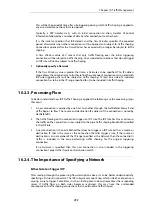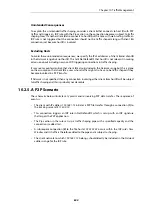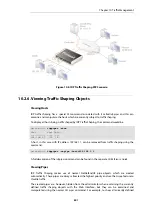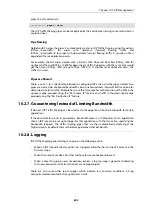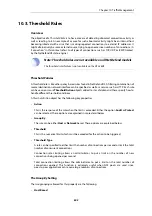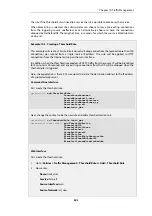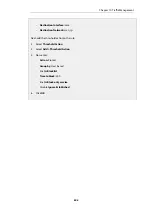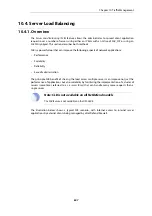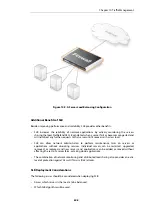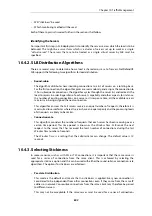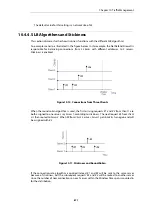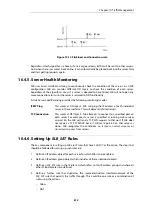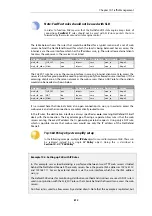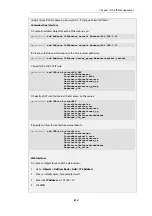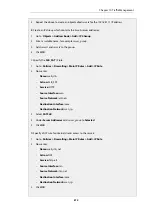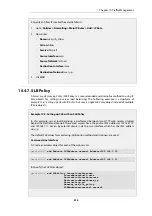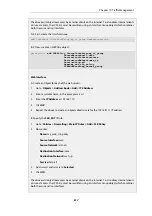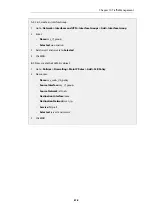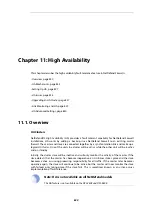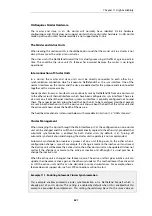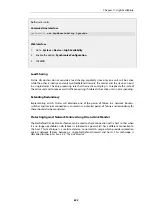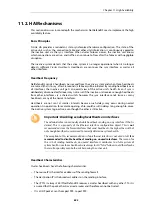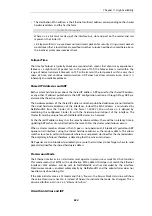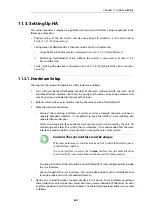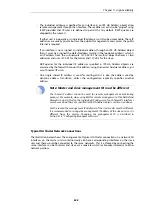
Note: FwdFast rules should not be used with SLB
In order to function, SLB requires that the NetDefendOS state engine keeps track of
connections.
FwdFast
IP rules should not be used with SLB since packets that are
forwarded by these rules are under state engine control.
The table below shows the rules that would be defined for a typical scenario of a set of web
servers behind the NetDefend Firewall for which the load is being balanced. Access across the
internet is via the
wan
interface which has the IP address
wan_ip
. The rules allow external clients
to access the web servers. The service is not listed.
Rule Name
Action
Src Interface
Src Network
Dest Interface
Dest Network
Service
web_slb
SLB_SAT
any
all-nets
core
wan_ip
http-all
web_slb_allow
Allow
wan
all-nets
core
wan_ip
http-all
The
SLB_SAT
rule has
any
as the source interface in case any internal clients want to access the
server (an interface group could be used to precisely specify the allowed source interfaces). If the
accessing clients are on the same network as the web servers then an
NAT
rule for those clients
would also be needed as shown below:
Rule Name
Action
Src Interface
Src Network
Dest Interface
Dest Network
Service
web_slb
SLB_SAT
any
all-nets
core
wan_ip
http-all
web_slb_nat
NAT
lan
lan_net
core
wan_ip
http-all
web_slb_allow
Allow
wan
all-nets
core
wan_ip
http-all
It is assumed here that internal clients also open connections to
wan_ip
in order to access the
web servers and so their connections are automatically routed to
core
.
In the IP rules, the destination interface is always specified as core, meaning NetDefendOS itself
deals with the connection. The key advantage of having a separate
Allow
rule is that the web
servers can log the exact IP address that is generating external requests. Using only a
NAT
rule,
which is possible, means that web servers would see only the IP address of the NetDefend
Firewall.
Tip: SLB Policy objects simplify setup
In the following example, multiple
IP Rule
objects are used to implement SLB. These can
be replaced instead by a single
IP Policy
object. Doing this is described in
Example 10.4. Setting up SLB with IP Rules
In this example, server load balancing is performed between two HTTP web servers situated
behind the NetDefend Firewall. These web servers have the private IPv4 addresses
192.168.1.10
and
192.168.1.11
. Access by external clients is via the
wan
interface which has the IPv4 address
wan_ip
.
The default SLB values for monitoring, distribution method and stickiness are used. A
NAT
rule is
used in conjunction with the
SLB_SAT
rule so that clients behind the firewall can access the web
servers.
An
Allow
rule is used to allow access by external clients. Note that this example is replicated, but
Chapter 10: Traffic Management
813
Summary of Contents for NetDefendOS
Page 30: ...Figure 1 3 Packet Flow Schematic Part III Chapter 1 NetDefendOS Overview 30 ...
Page 32: ...Chapter 1 NetDefendOS Overview 32 ...
Page 144: ...Chapter 2 Management and Maintenance 144 ...
Page 284: ...Chapter 3 Fundamentals 284 ...
Page 392: ...Chapter 4 Routing 392 ...
Page 419: ... Host 2001 DB8 1 MAC 00 90 12 13 14 15 5 Click OK Chapter 5 DHCP Services 419 ...
Page 420: ...Chapter 5 DHCP Services 420 ...
Page 573: ...Chapter 6 Security Mechanisms 573 ...
Page 607: ...Chapter 7 Address Translation 607 ...
Page 666: ...Chapter 8 User Authentication 666 ...
Page 775: ...Chapter 9 VPN 775 ...
Page 819: ...Chapter 10 Traffic Management 819 ...
Page 842: ...Chapter 11 High Availability 842 ...
Page 866: ...Default Enabled Chapter 13 Advanced Settings 866 ...
Page 879: ...Chapter 13 Advanced Settings 879 ...

